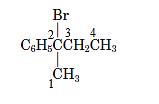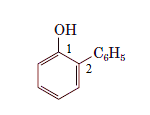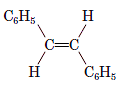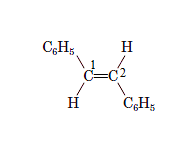
Concept explainers
(a)
Interpretation:The name of the following compound should be determined:

Concept Introduction: International Union of Pure and Applied Chemistry (IUPAC) recommended a nomenclature method used for naming organic chemical compounds.
(a)
Answer to Problem 59P
1-chloro-4-nitrobenzene.
Explanation of Solution
For the given organic compound, the number of substituents present on benzene ring is two and no substituent in the compound imparts special name. So, the numbering is done according to alphabetical order:

The name of the substituent at position 1 is chloro and at position 4 is nitro. So, the name of the compound is 1-chloro-4-nitrobenzene.
(b)
Interpretation: The name of the following compound should be determined:

Concept Introduction: International Union of Pure and Applied Chemistry (IUPAC) recommended a nomenclature method used for naming organic chemical compounds.
(b)
Answer to Problem 59P
2-bromotoluene.
Explanation of Solution
For the given organic compound, the number of substituents present on benzene ring is two and due to presence of methyl group its parent molecule is -toluene. The numbering for rest substituent is done as shown:

The name of the substituent is -bromo and is present at position 2 so, the name of the compound is 2-bromotoluene.
(c)
Interpretation: The name of the following compound should be determined:
Concept Introduction: International Union of Pure and Applied Chemistry (IUPAC) recommended a nomenclature method used for naming organic chemical compounds.
(c)
Answer to Problem 59P
1-chloro-3-phenylpropane.
Explanation of Solution
In
The substituent at position 1 is chloro so, the name of the compound is 1-chloro-3-phenylpropane.
(d)
Interpretation: The name of the following compound should be determined:

Concept Introduction: International Union of Pure and Applied Chemistry (IUPAC) recommended a nomenclature method used for naming organic chemical compounds.
(d)
Answer to Problem 59P
2-bromo-2-phenylbutane.
Explanation of Solution
In the given compound,

The substituent at position 2 is bromo so, the name of the compound is 2-bromo-2-phenylbutane.
(e)
Interpretation: The name of the following compound should be determined:

Concept Introduction: International Union of Pure and Applied Chemistry (IUPAC) recommended a nomenclature method used for naming organic chemical compounds.
(e)
Answer to Problem 59P
2-nitroaniline.
Explanation of Solution
For the given organic compound, the number of substituents present on benzene ring is two and due to presence of

The name of the substituent is -nitro present at position 2 so, the name of the compound is 2-nitroaniline.
(f)
Interpretation: The name of the following compound should be determined:

Concept Introduction: International Union of Pure and Applied Chemistry (IUPAC) recommended a nomenclature method used for naming organic chemical compounds.
(f)
Answer to Problem 59P
2-phenylphenol.
Explanation of Solution
For the given organic compound, the number of substituents present on benzene ring is two and due to presence of hydroxyl group its parent molecule is -phenol. The numbering for the substituent is done as shown:

The name of the substituent is -phenyl present at position 2 so, the name of the compound is 2-phenylphenol.
(g)
Interpretation: The name of the following compound should be determined:

Concept Introduction: International Union of Pure and Applied Chemistry (IUPAC) recommended a nomenclature method used for naming organic chemical compounds.
(g)
Answer to Problem 59P
trans -1,2-diphenylethene.
Explanation of Solution
In the given compound,

The phenyl substituents are present at opposite sides of the double bond so, the name of the compound istrans -1,2-Diphenylethene
(h)
Interpretation: The name of the following compound should be determined:

Concept Introduction: International Union of Pure and Applied Chemistry (IUPAC) recommended a nomenclature method used for naming organic chemical compounds.
(h)
Answer to Problem 59P
2,4-dichlorotoluene.
Explanation of Solution
For the given organic compound, the number of substituents present on benzene ring are three and due to presence of methyl group its parent molecule is -toluene. The numbering for the substituent is done as shown:

The name of the substituent is -chloro present at position 2 and 4 so, the name of the compound is 2,4-dichlorotoluene.
Want to see more full solutions like this?
Chapter 12 Solutions
Introduction to General, Organic and Biochemistry
- Including activity, calculate the solubility of Pb(IO3)2 in a matrix of 0.020 M Mg(NO3)2.arrow_forwardIncluding activity coefficients, find [Hg22+] in saturated Hg2Br2 in 0.00100 M KBr.arrow_forwardIncluding activity, calculate the pH of a 0.010 M HCl solution with an ionic strength of 0.10 M.arrow_forward
- Can I please get the graph 1: Concentration vs. Density?arrow_forwardOrder the following series of compounds from highest to lowest reactivity to electrophilic aromatic substitution, explaining your answer: 2-nitrophenol, p-Toluidine, N-(4-methylphenyl)acetamide, 4-methylbenzonitrile, 4-(trifluoromethyl)benzonitrile.arrow_forwardOrdene la siguiente serie de compuestos de mayor a menor reactividad a la sustitución aromática electrofílica, explicando su respuesta: ácido bencenosulfónico, fluorobenceno, etilbenceno, clorobenceno, terc-butilbenceno, acetofenona.arrow_forward
- Can I please get all final concentrations please!arrow_forwardState the detailed mechanism of the reaction of benzene with isopropanol in sulfuric acid.arrow_forwardDo not apply the calculations, based on the approximation of the stationary state, to make them perform correctly. Basta discard the 3 responses that you encounter that are obviously erroneous if you apply the formula to determine the speed of a reaction. For the decomposition reaction of N2O5(g): 2 N2O5(g) · 4 NO2(g) + O2(g), the following mechanism has been proposed: N2O5 -> NO2 + NO3_(K1) NO2 + NO3 →> N2O5 (k-1) → NO2 + NO3 → NO2 + O2 + NO (K2) NO + N2O5 → NO2 + NO2 + NO2 (K3) Give the expression for the acceptable rate. (A). d[N₂O] dt = -1 2k,k₂[N205] k₁+k₂ d[N₂O5] (B). dt =-k₁[N₂O₂] + k₁[NO2][NO3] - k₂[NO2]³ (C). d[N₂O] dt =-k₁[N₂O] + k₁[N205] - K3 [NO] [N205] (D). d[N2O5] =-k₁[NO] - K3[NO] [N₂05] dtarrow_forward
- A 0.10 M solution of acetic acid (CH3COOH, Ka = 1.8 x 10^-5) is titrated with a 0.0250 M solution of magnesium hydroxide (Mg(OH)2). If 10.0 mL of the acid solution is titrated with 20.0 mL of the base solution, what is the pH of the resulting solution?arrow_forwardFor the decomposition reaction of N2O5(g): 2 N2O5(g) → 4 NO2(g) + O2(g), the following mechanism has been proposed: N2O5 NO2 + NO3 (K1) | NO2 + NO3 → N2O5 (k-1) | NO2 + NO3 NO2 + O2 + NO (k2) | NO + N2O51 NO2 + NO2 + NO2 (K3) → Give the expression for the acceptable rate. → → (A). d[N205] dt == 2k,k₂[N₂O₂] k₁+k₁₂ (B). d[N2O5] =-k₁[N₂O] + k₁[NO₂] [NO3] - k₂[NO₂]³ dt (C). d[N2O5] =-k₁[N₂O] + k [NO] - k₂[NO] [NO] d[N2O5] (D). = dt = -k₁[N2O5] - k¸[NO][N₂05] dt Do not apply the calculations, based on the approximation of the stationary state, to make them perform correctly. Basta discard the 3 responses that you encounter that are obviously erroneous if you apply the formula to determine the speed of a reaction.arrow_forwardFor the decomposition reaction of N2O5(g): 2 N2O5(g) → 4 NO2(g) + O2(g), the following mechanism has been proposed: N2O5 NO2 + NO3 (K1) | NO2 + NO3 → N2O5 (k-1) | NO2 + NO3 NO2 + O2 + NO (k2) | NO + N2O51 NO2 + NO2 + NO2 (K3) → Give the expression for the acceptable rate. → → (A). d[N205] dt == 2k,k₂[N₂O₂] k₁+k₁₂ (B). d[N2O5] =-k₁[N₂O] + k₁[NO₂] [NO3] - k₂[NO₂]³ dt (C). d[N2O5] =-k₁[N₂O] + k [NO] - k₂[NO] [NO] d[N2O5] (D). = dt = -k₁[N2O5] - k¸[NO][N₂05] dt Do not apply the calculations, based on the approximation of the stationary state, to make them perform correctly. Basta discard the 3 responses that you encounter that are obviously erroneous if you apply the formula to determine the speed of a reaction.arrow_forward
 Living By Chemistry: First Edition TextbookChemistryISBN:9781559539418Author:Angelica StacyPublisher:MAC HIGHER
Living By Chemistry: First Edition TextbookChemistryISBN:9781559539418Author:Angelica StacyPublisher:MAC HIGHER Chemistry for Engineering StudentsChemistryISBN:9781337398909Author:Lawrence S. Brown, Tom HolmePublisher:Cengage Learning
Chemistry for Engineering StudentsChemistryISBN:9781337398909Author:Lawrence S. Brown, Tom HolmePublisher:Cengage Learning World of Chemistry, 3rd editionChemistryISBN:9781133109655Author:Steven S. Zumdahl, Susan L. Zumdahl, Donald J. DeCostePublisher:Brooks / Cole / Cengage Learning
World of Chemistry, 3rd editionChemistryISBN:9781133109655Author:Steven S. Zumdahl, Susan L. Zumdahl, Donald J. DeCostePublisher:Brooks / Cole / Cengage Learning Introductory Chemistry: An Active Learning Approa...ChemistryISBN:9781305079250Author:Mark S. Cracolice, Ed PetersPublisher:Cengage Learning
Introductory Chemistry: An Active Learning Approa...ChemistryISBN:9781305079250Author:Mark S. Cracolice, Ed PetersPublisher:Cengage Learning Introductory Chemistry: A FoundationChemistryISBN:9781337399425Author:Steven S. Zumdahl, Donald J. DeCostePublisher:Cengage Learning
Introductory Chemistry: A FoundationChemistryISBN:9781337399425Author:Steven S. Zumdahl, Donald J. DeCostePublisher:Cengage Learning





